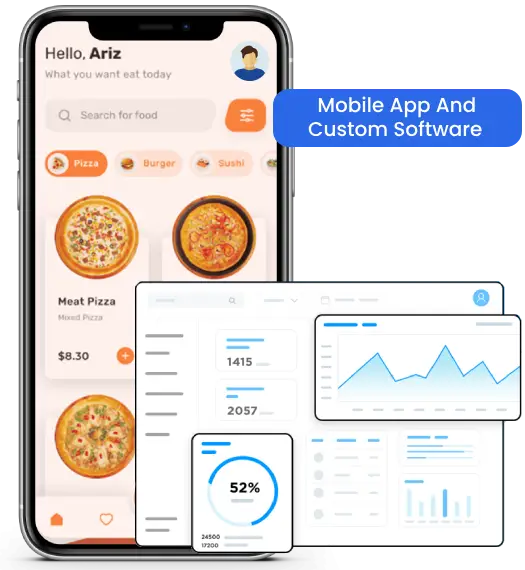Developing mobile applications with the help of React Native is an efficient way of bringing applications to life on Google Play Store and Apple App Store. However, relying purely on React Native is quite challenging because it comes with few advantages and challenges like every other programming language. Handling the challenges and crafting a mobile application that is optimized for both the operating system totally depends on the expertise of the developer.
Developing an application from scratch requires time, patience, money and expertise which often everyone doesn’t have. However, building applications with pre-build widgets, designs and code not only spikes the development speeds and helps in dropping costs. In this blog, we will discuss everything associated with react native app development.
React Native, while offering numerous advantages, comes with its own set of challenges:
Performance Issues
- Rendering Performance: Complex UI components can sometimes lead to performance bottlenecks.
- JavaScript Bridge: Communication between native and JavaScript layers can introduce latency.
Platform-Specific Code
- Native Module Development: For complex features, writing platform-specific code might be necessary.
- Codebase Management: Managing code for both iOS and Android platforms can be challenging.
Limited Access to Native APIs
- Feature Restrictions: React Native might not provide access to all native APIs and features.
- Workarounds: Finding alternative solutions or using native modules can be time-consuming.
Third-Party Library Reliance
- Dependency Management: Managing and updating third-party libraries can be complex.
- Compatibility Issues: Compatibility problems between libraries might arise.
UI Consistency
- Platform-Specific Design: Achieving consistent UI across platforms requires careful attention to detail.
- Design Challenges: Complex UI designs might be more challenging to implement in React Native.
Community and Ecosystem
- Rapid Changes: The React Native ecosystem evolves quickly, requiring constant updates.
- Limited Resources: Some specific features might lack sufficient community support.
By understanding these challenges, developers can effectively plan and execute React Native projects, ensuring successful custom mobile app development.
How to Handle Common Issues in React Native Apps?
React Native, while powerful, presents unique challenges. Here’s how to tackle some common issues:
Performance Optimization
- Profile your app: Identify performance bottlenecks using tools like React Native Profiler.
- Optimize rendering: Use PureComponent, shouldComponentUpdate, and memoization effectively.
- Reduce JavaScript thread load: Offload heavy computations to native modules.
- Optimize images: Use appropriate image formats and sizes.
Managing Dependencies
- Careful selection: Choose reliable and well-maintained libraries.
- Regular updates: Keep dependencies up to date to address vulnerabilities and improve performance.
- Dependency management tools: Utilize tools like npm or yarn to manage dependencies effectively.
Bridging Native Modules
- Clear communication: Define clear interfaces between JavaScript and native code.
- Asynchronous operations: Handle asynchronous operations efficiently to avoid UI freezes.
- Error handling: Implement robust error handling mechanisms.
UI Consistency
- Platform-specific styles: Use platform-specific styles to match native look and feel.
- Design systems: Create a design system to ensure consistency across platforms.
- Testing on different devices: Thoroughly test the app on various devices and screen sizes.
Debugging and Troubleshooting
- React Native Debugger: Utilize the built-in debugger for effective debugging.
- Logging: Implement detailed logging to track issues.
- Community resources: Leverage online forums and communities for support.
By addressing these common issues, you can improve the performance, stability, and user experience of your React Native app.
How Much Does React Native App Development Costs?
The cost of developing a React Native app can range from $5,000 to $50,000 or more. The exact cost depends on several factors:
Factors Affecting React Native App Development Cost
- App Complexity: Simple apps with basic features are less expensive than complex apps with advanced functionalities.
- Design Complexity: Elaborate designs and intricate user interfaces increase development time and cost.
- Development Team Location: Costs vary significantly based on the location of the development team.
- Additional Features: Features like in-app purchases, push notifications, and integrations increase costs.
Cost Breakdown
- Simple App: $5,000 – $15,000
- Medium Complexity App: $15,000 – $50,000
- Complex App: $50,000+
It’s essential to remember that these are rough estimates. The actual cost can fluctuate significantly based on specific project requirements. If you wish to know the exact pricing, then we highly recommend you consult with us!
What are React Native Pros and Cons?
React Native has undoubtedly revolutionized mobile app development by allowing developers to build cross-platform applications with a single codebase. However, it’s essential to weigh the pros and cons before committing to this framework.
The Pros
- Faster development: Write once, run everywhere philosophy accelerates time-to-market.
- Cost-effective: Reduced development costs compared to native app development.
- Large and active community: Strong community support and resources available.
- Hot reloading: Streamlined development process with instant updates.
The Cons
- Performance limitations: Can sometimes struggle with complex UI or computationally intensive tasks.
- Platform-specific code: Might require native modules for certain features.
- Debugging challenges: Can be more complex than native development.
Summary
Ultimately, the decision to use React Native depends on your specific project requirements. For simple apps with a focus on user interface and user experience, React Native can be an excellent choice. However, for apps demanding high performance and complex native features, native development might be more suitable.







